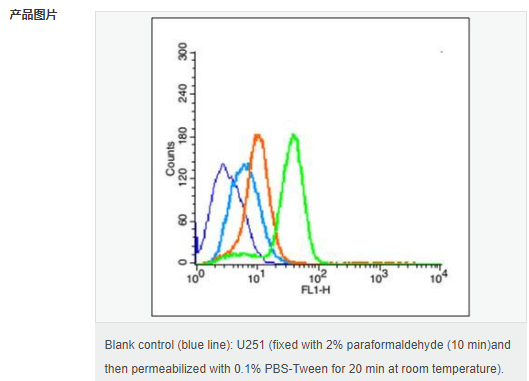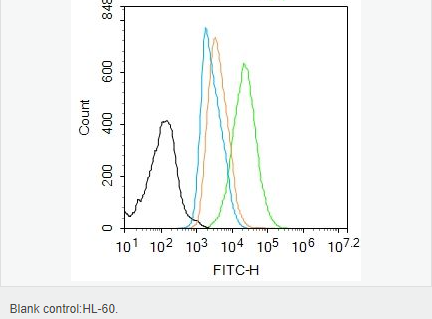

貨號(hào)
產(chǎn)品規(guī)格
售價(jià)
備注
BN40579R-100ul
100ul
¥2360.00
交叉反應(yīng):Human(predicted:Mouse,Rat,Dog,Pig,Cow,Horse,Sheep) 推薦應(yīng)用:Flow-Cyt,ELISA
BN40579R-200ul
200ul
¥3490.00
交叉反應(yīng):Human(predicted:Mouse,Rat,Dog,Pig,Cow,Horse,Sheep) 推薦應(yīng)用:Flow-Cyt,ELISA
產(chǎn)品描述
| 英文名稱 | RUNX2 |
| 中文名稱 | 核心結(jié)合因子α1/成骨特異性轉(zhuǎn)錄因子/Cbfα1抗體 |
| 別 名 | RUNX2_HUMAN; Runt-related Transcription Factor 2; CBF alpha 1; CBF-alpha-1; PEBP2-alpha A; CBFA1; CCD; CCD1; Cleidocranial dysplasia 1; Core binding factor; Core binding factor runt domain alpha subunit 1; Core binding factor subunit alpha 1; MGC120023; Oncogene AML 3; OSF 2; OSF2; OSF-2; Osteoblast specific transcription factor 2; OTTHUMP00000016533; PEA2 alpha A; PEA2aA; PEBP2 alpha A; PEBP2A1; PEBP2A2; PEBP2aA1; Polyomavirus enhancer binding protein 2 alpha A subunit; Runt domain; Runt related transcription factor 2; SL3 3 enhancer factor 1 alpha A subunit; SL3/AKV core binding factor alpha A subunit; AML3; CLCD. |
| 研究領(lǐng)域 | 干細(xì)胞 轉(zhuǎn)錄調(diào)節(jié)因子 表觀遺傳學(xué) |
| 抗體來源 | Rabbit |
| 克隆類型 | Polyclonal |
| 交叉反應(yīng) | Human, (predicted: Mouse, Rat, Dog, Pig, Cow, Horse, Sheep, ) |
| 產(chǎn)品應(yīng)用 | ELISA=1:5000-10000 Flow-Cyt=1μg/Test not yet tested in other applications. optimal dilutions/concentrations should be determined by the end user. |
| 分 子 量 | 57(hu)/67(mo,ratkDa |
| 細(xì)胞定位 | 細(xì)胞核 |
| 性 狀 | Liquid |
| 濃 度 | 1mg/ml |
| 免 疫 原 | KLH conjugated synthetic peptide derived from human RUNX2:201-300/521 |
| 亞 型 | IgG |
| 純化方法 | affinity purified by Protein A |
| 儲(chǔ) 存 液 | Preservative: 15mM Sodium Azide, Constituents: 1% BSA, 0.01M PBS, pH 7.4 |
| 保存條件 | Shipped at 4℃. Store at -20 °C for one year. Avoid repeated freeze/thaw cycles. |
| PubMed | PubMed |
| 產(chǎn)品介紹 | This gene is a member of the RUNX family of transcription factors and encodes a nuclear protein with an Runt DNA-binding domain. This protein is essential for osteoblastic differentiation and skeletal morphogenesis and acts as a scaffold for nucleic acids and regulatory factors involved in skeletal gene expression. The protein can bind DNA both as a monomer or, with more affinity, as a subunit of a heterodimeric complex. Mutations in this gene have been associated with the bone development disorder cleidocranial dysplasia (CCD). Transcript variants that encode different protein isoforms result from the use of alternate promoters as well as alternate splicing. [provided by RefSeq, Jul 2008]. Function: Transcription factor involved in osteoblastic differentiation and skeletal morphogenesis. Essential for the maturation of osteoblasts and both intramembranous and endochondral ossification. CBF binds to the core site, 5'-PYGPYGGT-3', of a number of enhancers and promoters, including murine leukemia virus, polyomavirus enhancer, T-cell receptor enhancers, osteocalcin, osteopontin, bone sialoprotein, alpha 1(I) collagen, LCK, IL-3 and GM-CSF promoters (By similarity). Inhibits MYST4-dependent transcriptional activation. [SUBUNIT] Interaction with SATB2 results in enhanced DNA binding and transactivation by these transcription factors (By similarity). Heterodimer of an alpha and a beta subunit. Interacts with HIVEP3 (By similarity). The alpha subunit binds DNA as a monomer and through the Runt domain. DNA-binding is increased by heterodimerization. Interacts with XRCC6 (Ku70) and XRCC5 (Ku80). Interacts with MYST3 and MYST4. Subunit: Heterodimer of an alpha and a beta subunit. Interacts with HIVEP3. The alpha subunit binds DNA as a monomer and through the Runt domain. DNA-binding is increased by heterodimerization. Interacts with G22P1 (Ku70) and XRCC5 (Ku80). Interacts with MYST3 and MYST4. Subcellular Location: Nucleus. Tissue Specificity: Specifically expressed in osteoblasts. Post-translational modifications: Phosphorylated; probably by MAP kinases (MAPK). Isoform 3 is phosphorylated on Ser340. DISEASE: Defects in RUNX2 are the cause of cleidocranial dysplasia (CLCD) [MIM:119600]; also known as cleidocranial dysostosis (CCD). CLCD is an autosomal dominant skeletal disorder with high penetrance and variable expressivity. It is due to defective endochondral and intramembranous bone formation. Typical features include hypoplasia/aplasia of clavicles, patent fontanelles, wormian bones (additional cranial plates caused by abnormal ossification of the calvaria), supernumerary teeth, short stature, and other skeletal changes. In some cases defects in RUNX2 are exclusively associated with dental anomalies. Similarity: Contains 1 Runt domain. SWISS: Q13950 Gene ID: 860 Database links: Entrez Gene: 860 Human Entrez Gene: 12393 Mouse Omim: 600211 Human SwissProt: Q13950 Human SwissProt: Q9XSB7 Horse SwissProt: Q08775 Mouse Unigene: 535845 Human Unigene: 391013 Mouse Unigene: 391017 Mouse Unigene: 214214 Rat Unigene: 83672 Rat Important Note: This product as supplied is intended for research use only, not for use in human, therapeutic or diagnostic applications. |


